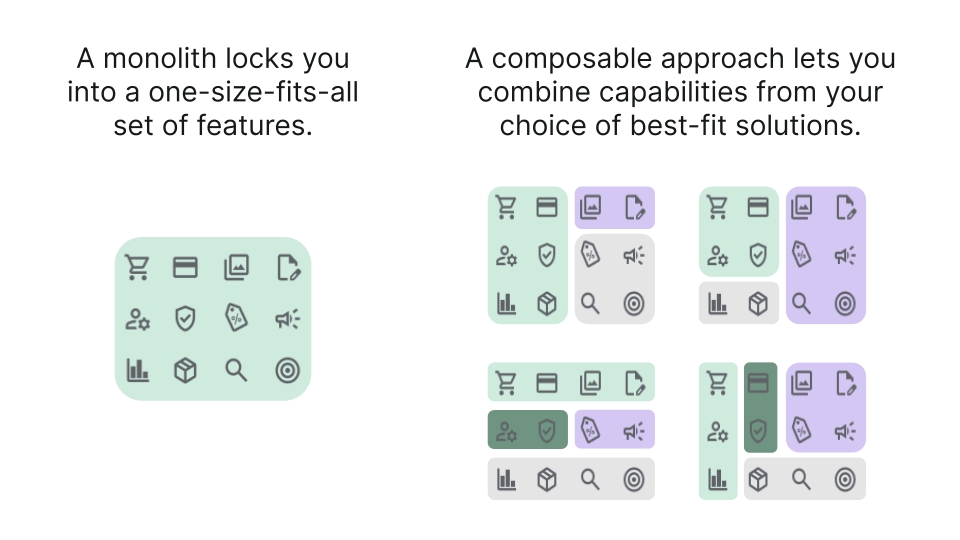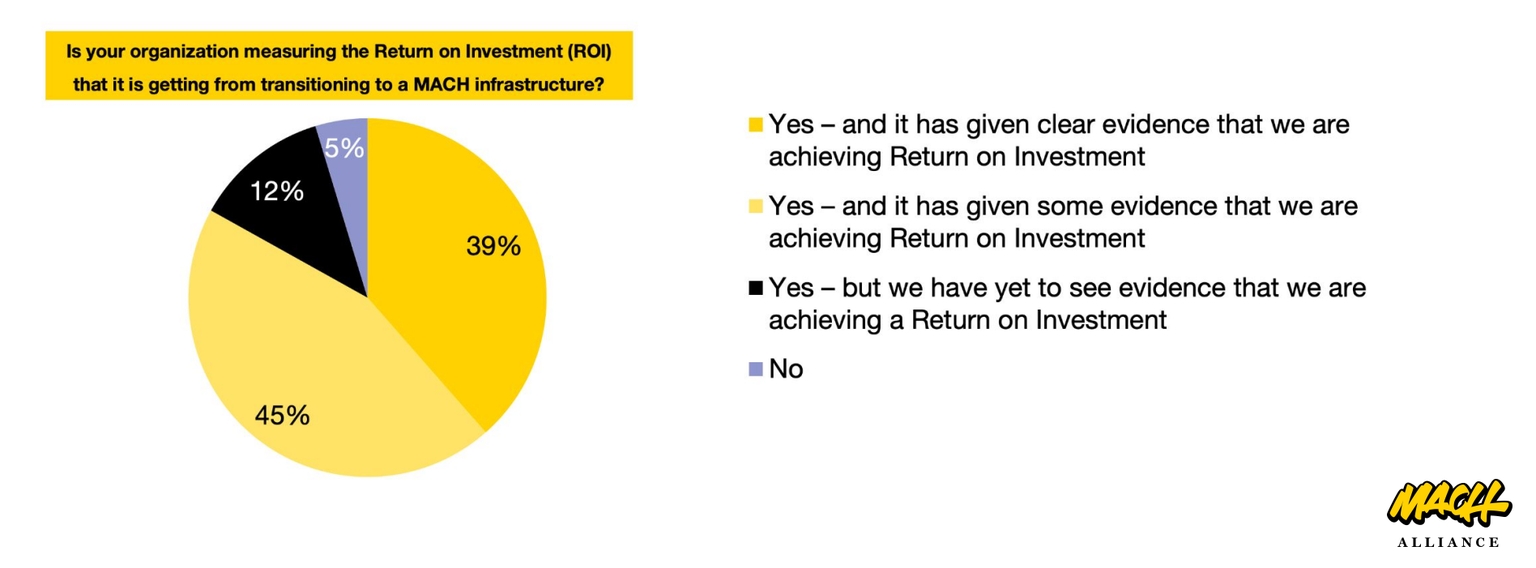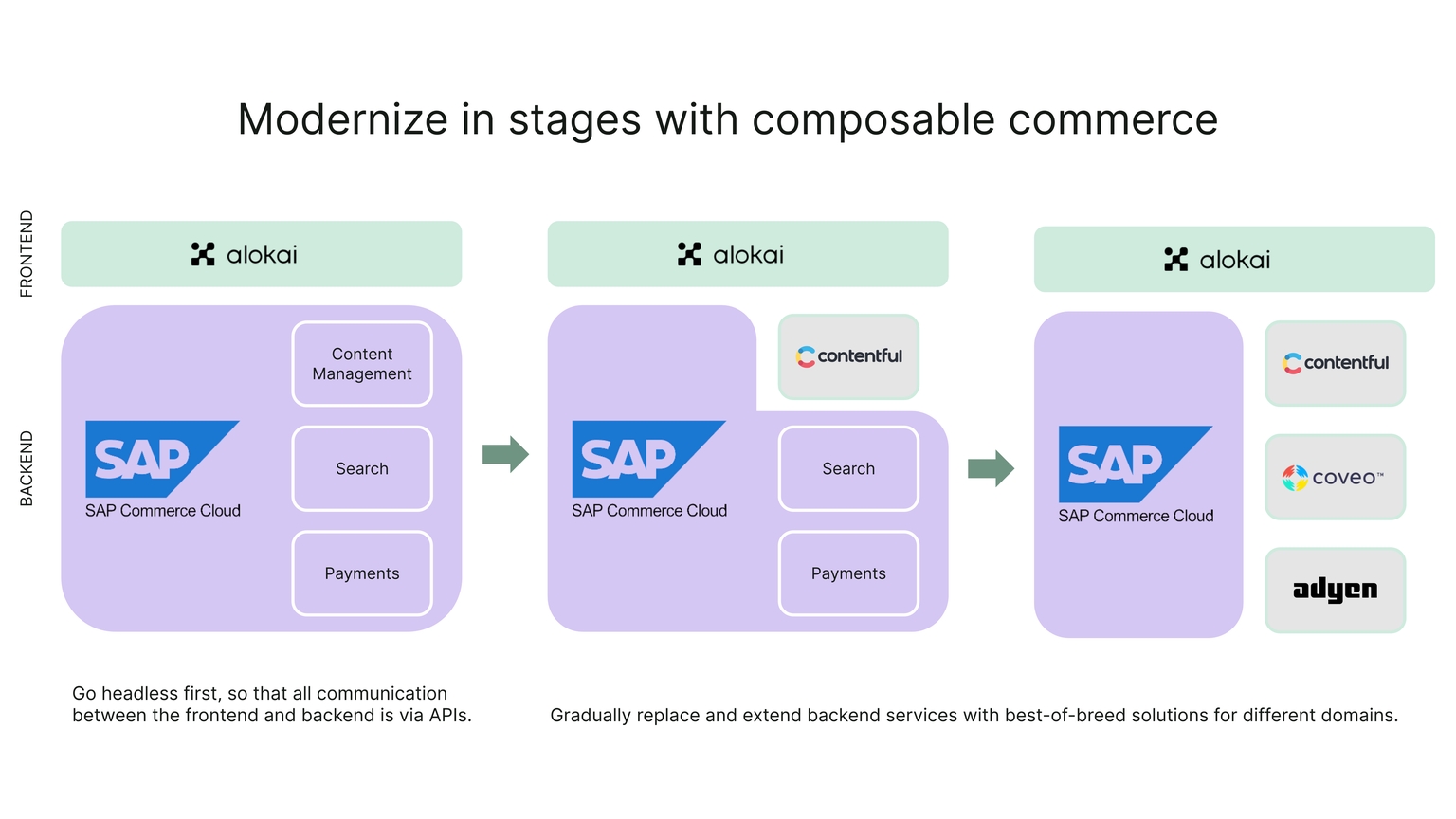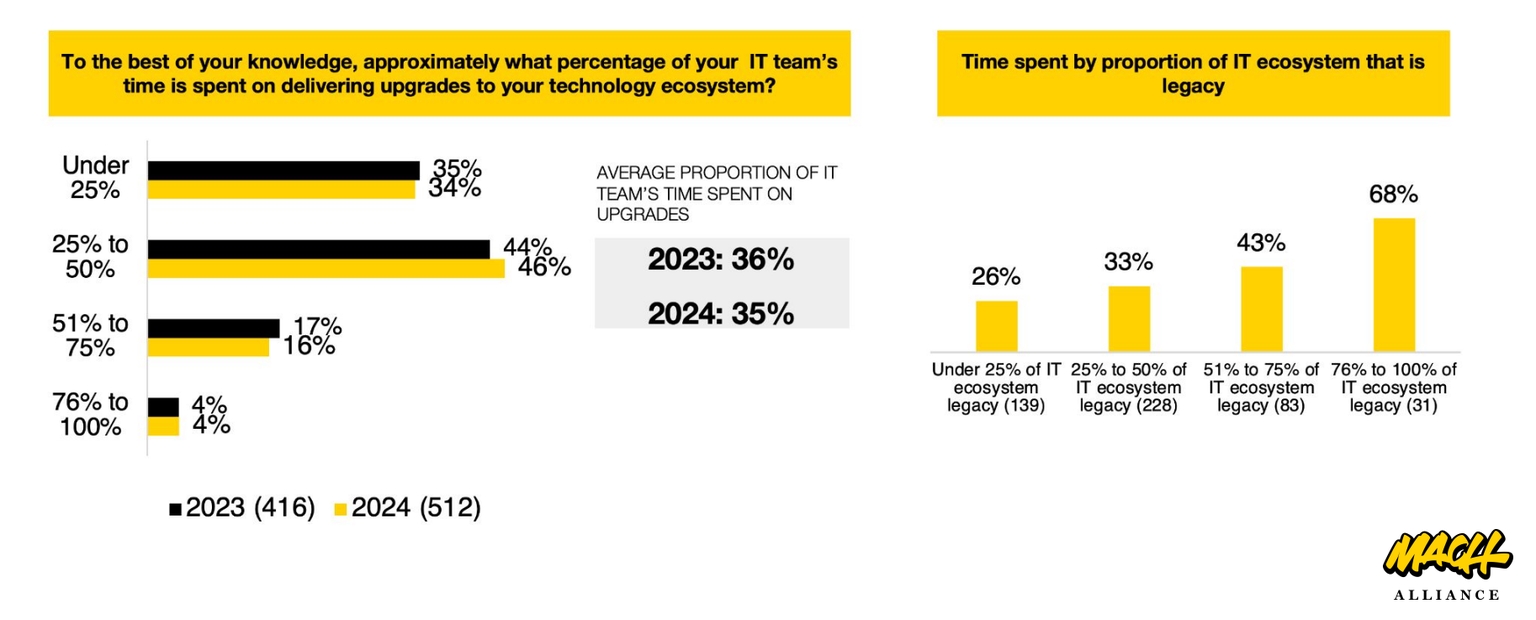The shift in the business technology market towards a composable approach has been fast. Just 4 years after Gartner introduced the idea of composable to its audience, the research firm now points to composability as the foundation of future-proof business.
At every level of the business technology stack, composable modularity has emerged as the foundational architecture for continuous access to adaptive change. Businesses rely on it to achieve sustainable business resilience and growth.
Gartner Research Predicts 2024: Composable Modularity Shapes the New Digital Foundation
This article takes a look at the core benefits that have led to the rapid adoption of composable commerce, and at 5 frequently heard myths that are holding businesses back from taking advantage of these benefits.
But first...
Why has composable commerce become so popular?
The core idea of a composable approach is that companies can “compose” their own unique tech stack with modular solutions that best-fit each area of business. Instead of being locked into a set of features from a single vendor, composable commerce lets teams mix-and-match capabilities of different solutions and easily add, remove, or replace features as needs change.

The modularity of this approach is largely supported by the growing number of technologies built with MACH principles (Microservices, API-first, Cloud-native, Headless). As opposed to a monolithic platform, where all features are tightly linked together in the code, MACH software breaks up functionality into individual services that communicate via APIs.
This gives businesses a lot more flexibility in how they integrate the capabilities of different software and, since the services are independent, lets teams make changes to functionality without risking a waterfall of errors across other parts of the experience.
According toGartner’s strategic planning assumption on MACH:
By 2027, at least 60% of new B2C and B2B digital commerce solutions, developed for the cloud, will be aligned with MACH architecture principles.
Gartner Research
When Should Applications Use a MACH Architecture Approach?
So what are the most common misconceptions about adopting the composable approach and how does the situation really look like?
Myth 1: You need to fully replatform to benefit from composable
Unlike a monolith-to-monolith replatform where you have to completely set up the new systems before migrating over in one big-bang effort, the migration to composable commerce can happen in steps.
The modularity of composable solutions, and the independent way their functionality works, means that making changes in one area doesn’t require rewiring the whole system. This flexibility lets teams start with composable in one part of the experience and expand the solution over time, without having to commit to a rigid plan from the outset.
This step-by-step approach also means you don’t need a complete system overhaul to start seeing tangible benefits. A MACH Alliance survey of technology decision makers found that, on average, respondents considered 49% of their architecture to be MACH-like solutions and that 83% of organizations that have implemented these solutions are already seeing measurable Return on Investment (ROI).

So, how does the migration to composable actually look like?
While the steps each company takes will differ, here are 2 common approaches when moving to composable commerce in stages.
Start by moving a distinct part of the customer experience (checkout, product pages, site search, reviews, etc) to a composable solution, usually a part that is frequently changed or is particularly frustrating to manage with the legacy system, and modernize the experience one slice at a time.
Start by moving a specific channel (mobile app, customer portal, regional site, etc) to a fully composable tech stack, usually one that can be launched with a minimal set of features, and gradually expand the solution as you roll it out to more complex channels.
Check how White Stuff approached their digital transformation with composable stack from Alokai
Myth 2: You have to abandon all legacy systems
Many resources and guides on moving to composable commerce make it seem like the ultimate end-goal is to have a fully MACH-based tech stack. For some companies this is true, but plenty of businesses have legacy tools they’d like to keep. These are usually solutions that are niche to their industry, those deeply ingrained in business processes, or simply those with the best-fit features for their team.
The beauty of a composable approach is that you get to choose the tech stack you want, including your preferred legacy tools.
This is greatly helped by the fact that the demand for composable commerce has been around long enough, and is loud enough, that vendors of many of the big legacy suites are now embracing the approach. Either by adding an API-layer to the platform or by completely rearchitecting the solution to better align with MACH principles, as in the case of the composable-ready version of SAP Commerce Cloud.
How do you go composable but keep your legacy tools, too, exactly?
Including legacy tools in your composable stack can be done with a headless approach, where backend systems only talk to the frontend (the head) via APIs. This “decoupling” is typically one of the first steps of going composable, as it lets youimmediately improve the frontend customer experience without any major backend changes.
Teams can then choose which parts of their legacy platforms they’d like to keep, and gradually replace other functionality with more modern backend services.

Myth 3: Composable commerce costs more than legacy solutions
Going from a single vendor suite to a multi-vendor tech stack does take an upfront investment to set up the new system, retrain staff, and hire agencies or internal talent with the right skillset. It also brings new challenges to procure and manage multiple vendor solutions. This initial cost and complexity can lead some companies to believe that going composable would be significantly more expensive than staying on their legacy monolith.
Yet, according to a MACH Alliance survey of technology decision makers,41% of organizations see cost reduction as a top driver to move to a MACH infrastructure. Which makes sense, because a composable approach offers multiple ways to improve the Total Cost of Ownership (TCO) of technology investment.
Right-size investment with modular capabilities
Instead of paying top price for a suite of features you only use half of, composable commerce lets you decide where it makes sense to invest in advanced capabilities, when to go with the cost-effective option, and which functionality you don’t need at all. Composable stack comes with the flexibility to add, swap, or remove capabilities as priorities and budgets change.
Reduce maintenance costs with MACH architecture
Independent, API-based services are easier to maintain as they can be changed, tested, and deployed without affecting the entire system. This modularity also helps to minimize technical debt, as outdated or inefficient parts of the system can be removed or replaced without a complete overhaul.
Many composable, MACH-based solutions are also delivered as Software-as-a-Service (SaaS), which means that the vendor is responsible for maintaining platform infrastructure and providing automatic, backwards compatible updates via the cloud.
With IT teams spending an average 35% of their time on upgrades, and 68% of the tech stack is over 3/4 legacy, the SaaS model can save businesses a substantial amount in overhead costs.

Increase productivity with modern tools
With a composable approach, teams can reuse modules to quickly launch new ideas. A developer can fast-track the build of a new regional site by replicating the environment of an existing one, while a marketer can spin up a new page by using existing components and filling them with fresh content.
Many of the leading tools in the composable space offer features that help both engineering and business teams work efficiently and autonomously. On top of that, thanks toprebuilt integrations and modules native to the composable nature, you can significantly speed up your time to market.
Grow revenue with a high-performing experience
Along with offering the tools that make it easier for teams to create unique and engaging experiences, composable solutions are typically built with modern development best practices which can help reduce page load time,decrease bounce rate, and improve other site performance metrics that can helpboost conversion and increase ecommerce revenue.
Forrester Total Economic Impact (TEI) reports offer a more in-depth look at the ways composable technologies can impact the bottom line. These reports, which are commissioned by a software vendor and conducted by Forrester research consultants, look at real customer use cases to calculate the financial impact of specific technologies.
Highlights of select TEI reports on composable, MACH-based solutions include:
90% reduction in time to publish with Contentstack CMS;
582% ROI over 3 years with Storyblok CMS;
$2M in developer time savings with Algolia search;
$774K in cost savings from retiring legacy solutions with BigCommerce.
See the full list of Alokai’s integration partners and unlock your dream composable stack!
Myth 4: You need an advanced engineering team to go composable
When composable commerce first entered the scene, early adopters were generally drawn to the approach because it allowed them to solve complex use cases in their own way. As a result, composable technology gained a bit of a reputation for being complex.
For a while, the notion that composable commerce was only for advanced engineering teams was pretty widely accepted. Especially back in the 2010s, when vendor solutions were relatively new to market and there weren’t many agencies with experience in building composable tech stacks. Early adopters had to blaze their own trail, not only to implement the technology effectively but also to persuade their business teams of its value.
It’s a very different case today. Market solutions are much more mature with years of investment in out-of-the-box capabilities, integrations, and user-friendly interfaces. There are plenty of system integrators with experience bringing these technologies together, many of which now specialize in composable and MACH solutions. While the growing number of companies have successfully made the transition has led to a wealth of shared knowledge and best practices. Overall, making composable commerce an accessible option for many different teams.
Alokai came pre-integrated into a number of vendors that we were reviewing, which massively accelerated the implementation. But it also gave us assurance because we knew such projects had been done before, it's a road well traveled. It wasn't something we were trying to do as the first pioneer or building bespoke. So it de-risked the program because we knew it's a working viable model.
James Brazeley
Enterprise Architect, White Stuff
Myth 5: You have to DIY your composable frontend
The majority of modern composable solutions on the market are headless which means that they can be used to power any frontend “head”. This frontend-agnostic design makes it possible to bring together the services of many different backend tools into one cohesive experience for customers.
It’s also why the marketing materials of these platforms tend to say something along the lines of “create your own frontend with your choice of framework.” Which can give the impression that to go composable you have to build the frontend from scratch.
While there are plenty of companies that do prefer to completely DIY the frontend, and many frameworks available to do so, the majority of teams want the flexibility to build the unique parts of their experience without having to rebuild the wheel. This is where Frontend-as-a-Service (FEaaS) comes in.
What is Frontend as a Service?
FEaaS solutions, like Alokai, provideprebuilt components and integrations that developers can use to get storefronts up and running quickly. Components are completely customizable, extendable, and built with a modern frontend framework, like React or Vue.js, so that companies can take full advantage of the flexibility of composable commerce.
High velocity is another part of the availability of resources. Developers are hard to find, so that affects the time-to-market. But Alokai’s simple and clear code and its developer-friendly environment make them more engaged. If you can develop 2x faster, it's a competitive advantage.
David Ting
CTO, Zenni Optical
Alokai further accelerates the shift to composable by simplifying the middleware challenge. Alokai Connect integrates and orchestrates the data across all your composite tools and delivers that connected data to the frontend in a single API call. Making it easy to offer tailored product recommendations, customized pricing, and other personalized experiences while ensuring site performance stays high.

If you’re curious about composable, don’t hesitate to get in touch and chat with one of our experts about composable benefits, challenges, and if it’s the right move for your business.



















